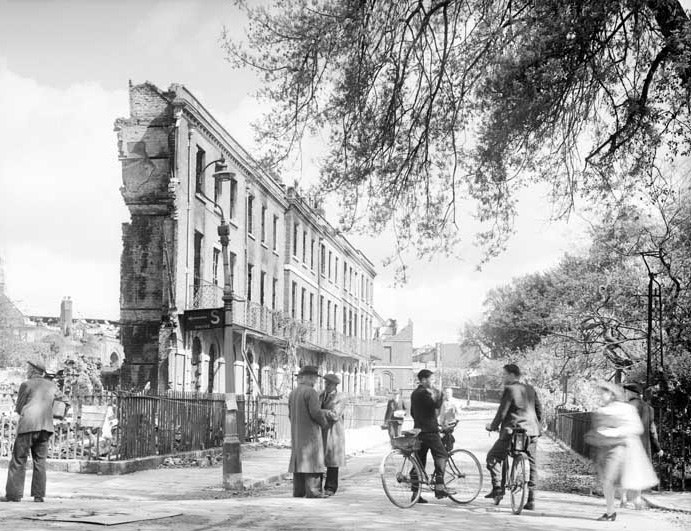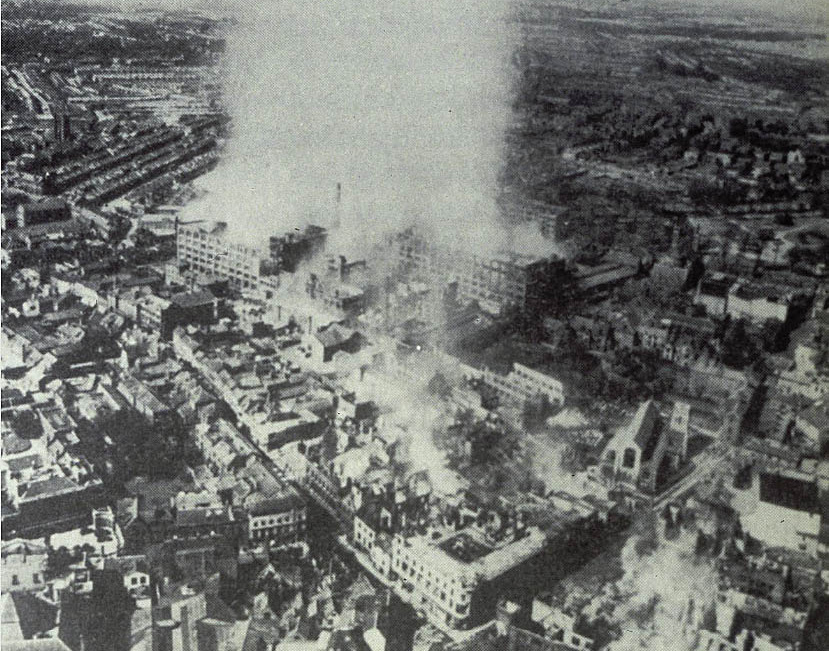Between late April and late June 1942, the Luftwaffe (German Air Force) deliberately targeted Britain’s historic towns and cities, causing widespread destruction, hundreds of deaths and thousands of injuries. The main targets were Exeter, Bath, Norwich, York and Canterbury.

These attacks on historic and cultural targets were known as the ‘Baedeker Raids’ after the famous German travel guides, and were in retaliation for the RAF bombing of the historic German city of Lübeck two months earlier on 28/29 March.

An RAF directive in February 1942 had authorised, for the first time, the targeting of civilian areas in Germany. Air Marshall Sir Arthur (‘Bomber’) Harris, Commander-in-Chief RAF Bomber Command, wrote in his memoirs that the main reason he chose the port city of Lübeck as the first target was: ‘…to learn to what extent a first wave of aircraft could guide a second wave to the aiming point by starting a conflagration.’ The city lacked defences, and in the firestorm 300 residents were killed and almost 1,000 injured, whilst the historic centre was severely damaged.
Hitler was enraged and personally sanctioned reprisal air raids on Britain, demanding: ‘…terror attacks…where the greatest possible effect on the civilian population was to be expected.’
Baron Gustav Braun von Sturm, a Nazi propagandist, reputedly suggested bombing significant historic sites listed in the Baedeker Guide: a 19th Century set of travel guides published by the Karl Baedeker firm.
Exeter

‘…The Cathedral was absolute chaos. The organ was everywhere. Pipes were everywhere. The whole of the south side of the choir was damaged. It was filled with smoke from fires burning all over the place. Not a window was left. Chairs were everywhere. Masonry all over the place. It was devastation…’ Interview with Wilfred Dymond, firewatcher Exeter Cathedral, recorded in 1995 © IWM 15451

Exeter was the Luftwaffe’s first target: there were 19 raids, two resulting in widespread damage and the heaviest casualties.

On 24/25 April 1942 German aircraft dropped high explosive bombs on the city, failing to do much damage, but killing 73 people and injuring 54.

The bombers returned just after midnight on 4 May, this time dropping an estimated 8,000 incendiary bombs. These ignited on landing, swiftly spreading roof fires. Enemy aircraft strafed the emergency personnel as they fought to contain the conflagration. In the deadly 70 minutes of the raid, much of the historic centre of Exeter was left in ruins: 156 people lost their lives and 563 were injured, whilst 1,500 houses were destroyed and 2,700 severely damaged.
Bath

Bath became a military target in night air raids between 25 and 27 April. The city was vulnerable to attack, having no anti-aircraft guns or barrage balloons. The Luftwaffe flew 151 bomber sorties on the 25th, first dropping flares to light up the targets, followed by over 200 tons of high explosives and 3,500 incendiary bombs, as well as dive bombing and machine-gunning the streets. Four German aircraft were downed, resulting in the deaths of 24 airmen and the capture of two.


Enemy aircraft returned the following night, mainly bombing houses in the old residential part of the city. The raids came at great human cost: 432 people lost their lives, almost 1,000 were injured, and hundreds made homeless.
Norwich

‘…The blitz in 1942 was terrible….where we lived and all round the areas was one mass of flames…we were all in terraced houses, the next door was completely burnt out…and I was outside on the road with a stirrup pump trying to dampen our house down so we didn’t get much damage to it…when we eventually did get down into the shelters there was incendiary bombs all burning in the gardens…’ Interview with John Fuller, messenger with Norwich City Fire Service, recorded in 1997 © IWM 17647.

The heaviest raids on Norwich were on the nights of 27/28 April and 29/30 April 1942. In total more than 200 citizens died and an estimated 850 were injured, whilst a number of historic buildings and homes in the city centre were also destroyed.

On 27 June the Luftwaffe attacked again: Norwich Cathedral was caught is a deadly rain of nearly 1,000 incendary bombs, but escaped serious damage owing to the vigilance of the firewatchers and the brick and stone vaulting within its roof.
York

‘…when they bombed York…all the building trades had to report to a central place and we were all allocated streets to go to to put sheets on the roofs and put up felt at the windows so people could go back as soon as posssible…’ Interview with Edwin Dales, a 14 year old plumber at the time of the raids. Recorded in 2000 © IWM 20152.
70 German aircraft attacked York on 28/29 April 1942: more than 90 civilians died, around 200 were injured and an estimated 9,500 houses were damaged or destroyed. Many public buildings also suffered damage, including the medieval Guildhall. The old Rowntree factory was burned to the ground; the railway station was badly damaged, with the incoming King’s Cross to Edinburgh train crowded with military taking a direct hit; the Bar Convent collapsed killing five nuns.


A plaque at York Station reads: ‘On 29 April 1942, York Railway Sation was attacked during a German air-raid. Foreman William Milner, a keen first-aider, went to the assistance of others trapped in damaged buildings. The following morning he was found dead nearby. He was still clutching his first-aid bag.’


Yves Mahé, a young French pilot, escaped to England during the Nazi occupation of France and joined the RAF’s No. 253 Squadron. On 29 April 1942, his was one of six Hurricanes from the Squadron that took off at 02.45 to attack the Luftwaffe and defend York.
Canterbury

‘…We were in the flight path of the German bombers going to Canterbury and they were so low…that we could almost see inside the cabins… I went into Canterbury the next day and… all the shops in the main street, they were pretty olde worlde….all the old beams, were all smouldering…it were pretty awful what they did…’ Ronald Clack, was serving with the 112th Field Regiment, Royal Artillery, and was posted to village close to Canterbury. Recorded in 2001. © IWM 20287.
Canterbury was raided on 31May/1 June 1942. Thousands of incendiary bombs and hundreds of high explosive bombs laid waste to its medieval heart: 115 people died and 380 were injured.

Fires raged across the city: over 800 properties were completely destroyed and over 1,000 seriously damaged. The Cathedral, which lost its library, survived- largely due to its fire watchers who doused the incendaries that had landed on the roof. A stone memorial plaque to their bravery was unveiled within the Cathedral in 2004.
Header Image: A view over bomb-damaged Exeter. The Cathedral appears virtually intact, but had lost two of its supporting flying buttresses and was badly damaged within. Photographed from the ruins of the Church of St Mary Arches, 7 September 1942 © Historic England BB42/03979.
Written by Nicky Hughes.
Further Reading
- What Remains, our new exhibition in partnership with the Imperial War Museum London, explores why cultural heritage is attacked during war and the ways we save, protect and restore what is targeted
- Military Histories – York
- Bath And The Baedecker Raids



I cannot ‘like’ this, not having or wanting a Facebook account [not everyone does!]
But is one of your best
Charles Kightly
My grand father David Jones was dean of Llandaff and was entering the cathedral on the night it was bombed. A bomb exploded and he was blown out of the door wearing his kitchen colander as a hat which got damaged. He spent the last few years of his life arranging for the cathedral repairs and installation of the Epstein sculpture in the crossing.
We still use the colander almost every day.
Thank you for that charming story. Such bravery, such a “never give up” approach to life – a remarkable testament to the British people.
Wish we could visit this remarkable exhibition.
In Frome Heritage Museum, Somerset, we have a first-hand account of the bombing of Exeter Cathedral. It was written by Miss Eunice Overend who was on fire-watching duties there and she vividly described the climbing and scrambling she had to do to put out the fires up on the Cathedral roof.This was selflessly done with no thought to her own safety.